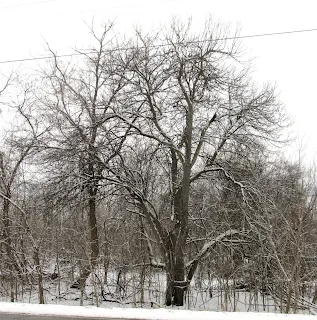 |
| Somewhere in Alberta. Image from GardenWeb. |
Apples are highly sought after by both humans and animals.
One of the few shortcomings of apple trees is their aversion to "wet feet". More and more the only parcels left over for wildlife are the swampy bits too wet to subdivide and build on or to plow up for row crops.
Apple trees with wet feet
One of my projects is to collect scion wood from apple trees growing in exceptionally wet places. It is a retiree project. There is no way one could justify paying money to collect this genetic material. The chance of an economic pay-off is too remote.
This tree is just south of Eaton Rapids city limits on M-188.
It is growing in close association with Pussy Willow (toppled), Red Osier Dogwood, Buttonbush, Reed Canarygrass and Skunk Cabbage. Skunk Cabbage means it is wet, wet, wet.
It is not Malus domestica but some kind of flowering crab. One weakness of small-fruited apple species is that they tend to be very sensitive to plant virus.
Site Two
Site Two is on Island Highway. Two of the three specimens are massive. They are Malus domestica. Associated vegetation includes Reed Canarygrass and Box Elder. This is the driest of the three sites. The water table is approximately 10" down.
Site Three
Site Three is next to M-100. This is the overview. There is standing water in the foreground. There are Cattails and Reed Canarygrass. There is Buttonbush growing behind this little island. Peak elevation of the island above the standing water is approximately 6". These are probably M. domestica.
 |
| This specimen leans, indicating weak rooting. This clone is less desirable than the other two at this location. |
My plan is to contact the owners of the property and offer $5 per scion to collect from their trees. Further, I plan to graft them all onto a tree that I am using to collect potential rootstock breeding material.









No comments:
Post a Comment
Readers who are willing to comment make this a better blog. Civil dialog is a valuable thing.